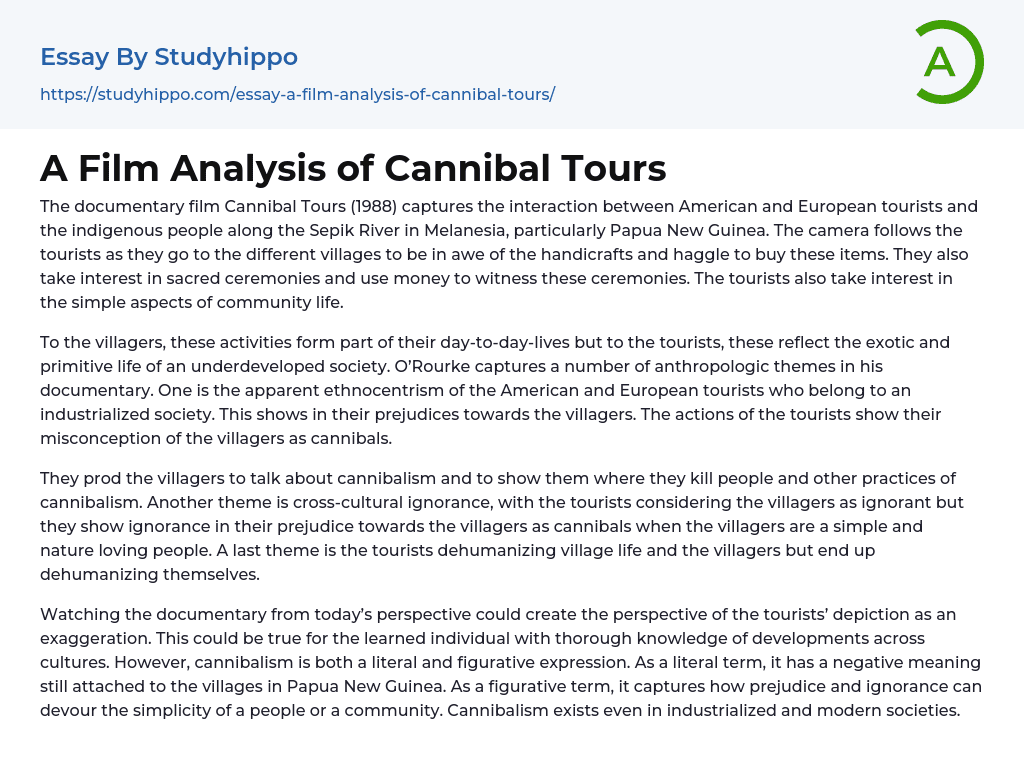The documentary film Cannibal Tours (1988) captures the interaction between American and European tourists and the indigenous people along the Sepik River in Melanesia, particularly Papua New Guinea. The camera follows the tourists as they go to the different villages to be in awe of the handicrafts and haggle to buy these items. They also take interest in sacred ceremonies and use money to witness these ceremonies. The tourists also take interest in the simple aspects of community life.
To the villagers, these activities form part of their day-to-day-lives but to the tourists, these reflect the exotic and primitive life of an underdeveloped society. O’Rourke captures a number of anthropologic themes in his documentary. One is the apparent ethnocentrism of the American and European tourists who belong to an industrialized society. This shows in their prejudices towards the villagers. The action
...s of the tourists show their misconception of the villagers as cannibals.
They prod the villagers to talk about cannibalism and to show them where they kill people and other practices of cannibalism. Another theme is cross-cultural ignorance, with the tourists considering the villagers as ignorant but they show ignorance in their prejudice towards the villagers as cannibals when the villagers are a simple and nature loving people. A last theme is the tourists dehumanizing village life and the villagers but end up dehumanizing themselves.
Watching the documentary from today’s perspective could create the perspective of the tourists’ depiction as an exaggeration. This could be true for the learned individual with thorough knowledge of developments across cultures. However, cannibalism is both a literal and figurative expression. As a literal term, it has a negative meaning still attached t
the villages in Papua New Guinea. As a figurative term, it captures how prejudice and ignorance can devour the simplicity of a people or a community. Cannibalism exists even in industrialized and modern societies.
- The Pursuit Of Happiness essays
- Multiculturalism essays
- Cultural Diversity essays
- Diversity essays
- Peer Pressure essays
- Oppression essays
- Racial Profiling essays
- Discrimination essays
- Ageism essays
- Sexism essays
- Gender Discrimination essays
- Aesthetics essays
- Art History essays
- Artist essays
- ballet essays
- Body Art essays
- Color essays
- Concert Review essays
- Creativity essays
- Cultural Anthropology essays
- Ethnography essays
- Harlem Renaissance essays
- Heritage essays
- Modernism essays
- Mona Lisa essays
- Pastoral essays
- Postmodernism essays
- Realism essays
- Symbolism essays
- Theatre essays
- Visual Arts essays
- Voice essays
- Work of art essays
- African American essays
- African American Culture essays
- American Values essays
- Asian American essays
- Chinese essays
- Ethnicity essays
- Ethnocentrism essays
- German essays
- Han Chinese essays
- Hispanic essays
- Identity essays
- Korean essays
- Mexican essays
- Nation essays
- Native American essays
- Race and Ethnicity essays
- White People essays




